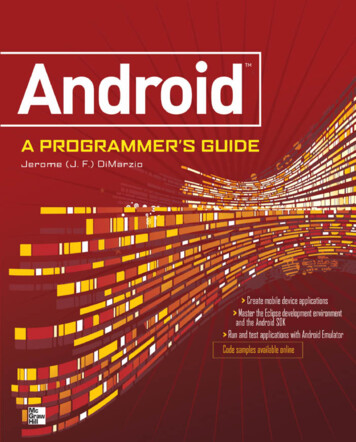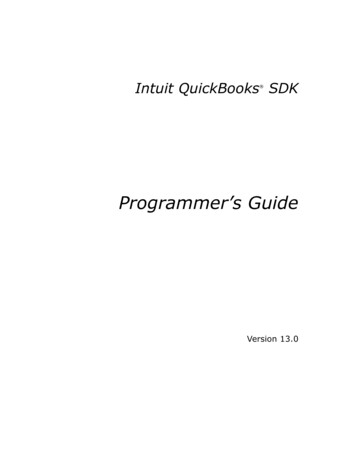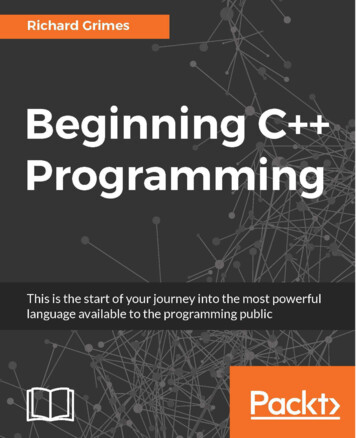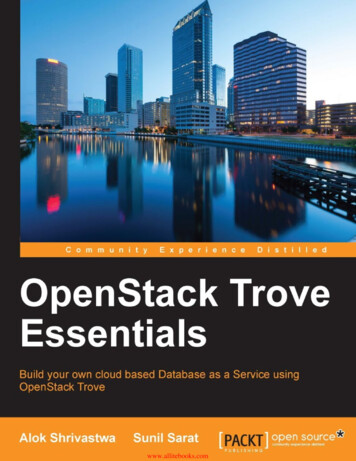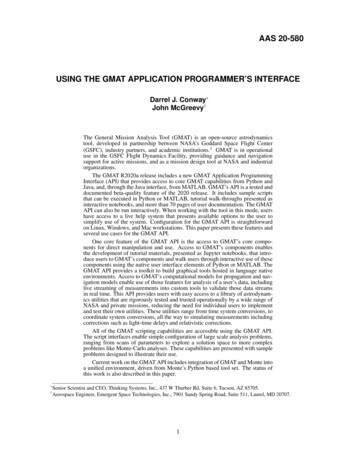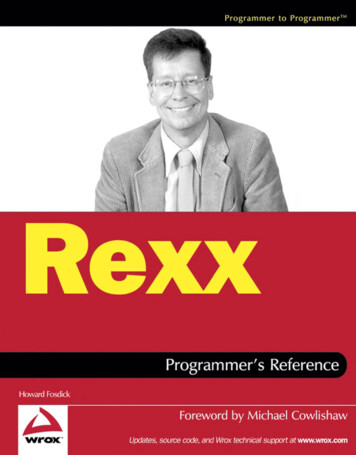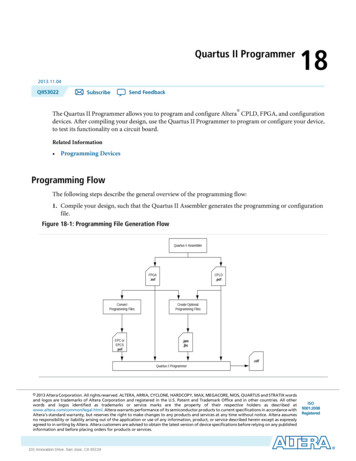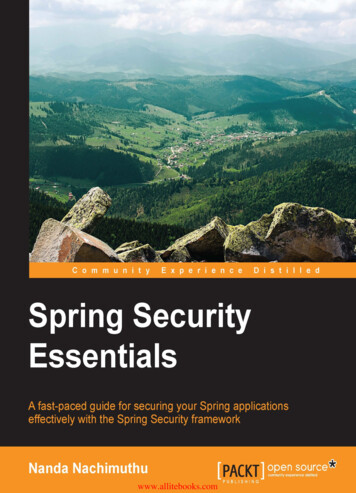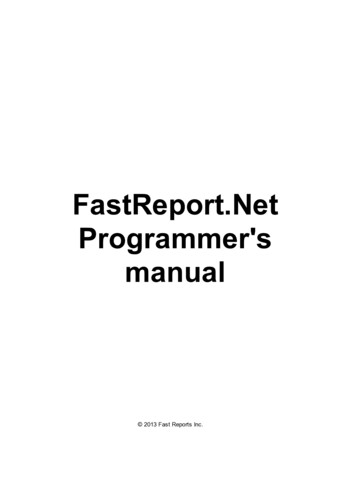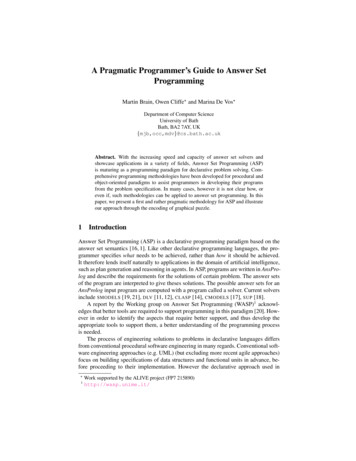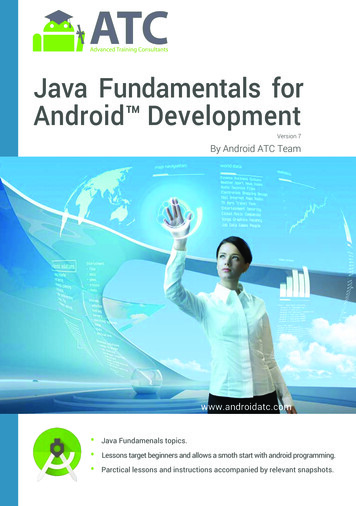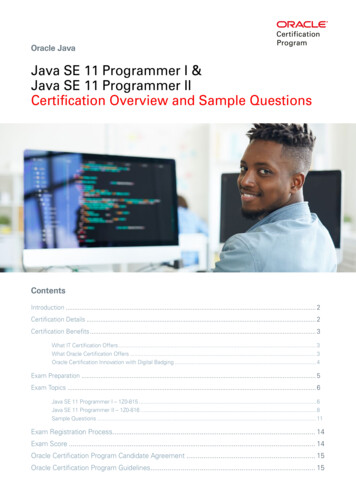
Transcription
Oracle JavaJava SE 11 Programmer I &Java SE 11 Programmer IICertification Overview and Sample QuestionsContentsIntroduction. 2Certification Details. 2Certification Benefits. 3What IT Certification Offers. 3What Oracle Certification Offers. 3Oracle Certification Innovation with Digital Badging. 4Exam Preparation. 5Exam Topics. 6Java SE 11 Programmer I – 1Z0-815. 6Java SE 11 Programmer II – 1Z0-816. 8Sample Questions. 11Exam Registration Process. 14Exam Score. 14Oracle Certification Program Candidate Agreement. 15Oracle Certification Program Guidelines. 15
IntroductionBeing a Professional Java Developer, means you have the skills covered in both exams – Java SE 11Programmer I and Java SE 11 Programmer II. The Java Developer certification at Oracle has always beento present the full stable of skills and knowledge through the Oracle Certified Professional credential.The Programming I course and Java SE 11 Programmer I exam focus on fundamental Java topics that laythe foundation for a Java Developer job role.The Programming II course and Java SE 11 Programmer II exam provide more-advanced layers of detail onprevious topics and go into new advanced topics such as lambdas and modularity.Certification Details Credential Awarded: Oracle Certified Professional Java SE 11 Developer Exam Number: 1Z0-815 & 1Z0-816 Target Audience: Java Developers Platform: Delivered via Pearson VUE Exam Duration: 180 minutes Number of Questions: 80 Passing Score: 63% Digital Badge: 2019 Oracle Certified Professional Java SE 11 Developer
Certification BenefitsWhat IT Certification OffersRecognitionOpportunitiesConfidence and Respectof having required skillsthrough new skillsby peers and management73%65%71%Experienced a Greater Demandfor Their SkillsReceived Positive Impact onProfessional ImageSaid Certification was a KeyFactor in Recent RaiseJanuary 2019 issue of CertificationMagazine’s annual salary surveyJanuary 2018 issue of CertificationMagazine’s annual salary surveyJanuary 2019 issue of CertificationMagazine’s annual salary surveyThe kind of longevity suggests that earning and maintaining a certification can keep you moving forwardin your career, perhaps indefinitely.What Oracle Certification OffersBy becoming a certified Java SE 11 Developer, you demonstrate proficiency in Java software developingrecognized by a wide range of worldwide industries.A Java certification is a validation of your skills. With a certification in-hand, you have a clear way to showemployers how and why you are prepared for the job. You also gain the knowledge you need to earnmore credibility, perform better in your daily job, and lead your team and company forward.
Oracle Certification Innovation with Digital BadgingCertification that Signifies Your Readiness to PerformEarned badges represent recognized skills and capabilitiesDisplay Your Oracle Certification BadgeYou‘ve earned it. Get the recognition you deserve.2019 Oracle Certified ProfessionalJava SE 11 DeveloperDisplay Your AchievementA secure way to display and share your certification achievementModern Representation of Skills Tied to Real Time Job MarketsView from your profile and apply to jobs that are matched to your skills;based on location, title, employers or salary rangeUse Your Badge to Apply for JobsBenefitsOracle Certification Signifies a Candidates Readiness to Perform Industry Recognized Credible Role Based Product Focused Across Database,Applications, Cloud, Systems,Middleware and JavaBoost Your Professional ImageLearn More: education.oracle.com/certification Globally one of the top 10 certificationprograms available
Exam PreparationBy passing this exam, a certified individual proves fluency in and solid understanding of the skills requiredto be a Java software developer.Recommendation to successfully prepare for Java SE 11 Programmer I 1Z0-815 &Java SE 11 Programmer II 1Z0-816 certification are:You should have: Minimum of 12 to 18 months of experience with Java. Knowledge of general programming concepts and techniques. Experience with any programming language.You would benefit in having experience in: Writing programs in Java. Use of Java IDE. Package and deploy Java apps.Attend Recommended Oracle Training:The Java SE Programming I and Java SE Programming II courses are currently available, and are terrifictools to help you prepare not only for your exam, but for your job as a Java Developer.
Exam Topics (Java SE 11 Programmer I – 1Z0-815)Understanding Java Technologyand environment Describe Java Technology and the Javadevelopment environment Identify key features of the Java languageCreating a Simple Java Program Create an executable Java program witha main class Compile and run a Java program fromthe command line Create and import packagesWorking With Java Primitive Data Typesand String APIsUsing Operators and Decision Constructs Declare and initialize variables (including castingand promoting primitive data types) Identify the scope of variable Use local variable type inference Create and manipulate Strings Manipulate data using the StringBuilder class andits methods Use Java operators including the use ofparenthesis to override operator precedence Use Java control statements including if, else,and switch Create and use do/while, while, for and for eachloops, including nested loops, use break andcontinue statementsWorking with Java ArraysDescribing and Using Objects and Classes Declare, instantiate, initialize and use aone-dimensional array Declare, instantiate, initialize and usetwo-dimensional array Declare and instantiate Java objects, and explainobjects’ lifecycles (including creation, dereferencingby reassignment, and garbage collection) Define the structure of a Java class Read or write to object fieldsCreating and Using MethodsApplying Encapsulation Create methods and constructors with argumentsand return values Create and invoke overloaded methods Apply the static keyword to methods and fields Apply access modifiers Apply encapsulation principles to a class
Exam Topics (Java SE 11 Programmer I – 1Z0-815)Reusing ImplementationsThrough InheritanceProgramming AbstractlyThrough Interfaces Create and use subclasses and superclassesCreate and extend abstract classesEnable polymorphism by overriding methodsUtilize polymorphism to cast and call methods,differentiating object type versus reference type Distinguish overloading, overriding, and hiding Create and implement interfaces Distinguish class inheritance from interfaceinheritance including abstract classes Declare and use List and ArrayList instances Understanding lambda ExpressionsHandling ExceptionUnderstanding Modules Describe the advantages of Exception handlingand differentiate among checked, uncheckedexceptions, and Errors Create try-catch blocks and determine howexceptions alter program flow Create and invoke a method that throws anexception Describe the Modular JDK Declare modules and enable access betweenmodules Describe how a modular project is compiledand run
Exam Topics (Java SE 11 Programmer II – 1Z0-816)Java FundamentalsException Handling and Assertions Create and use final classes Create and use inner, nested andanonymous classes Create and use enumerations Use try-with-resources construct Create and use custom exception classes Test invariants by using assertionsJava InterfacesGenerics and Collections Create and use interfaces with default methods Create and use interfaces with private methods Use wrapper classes, auto-boxingand auto-unboxing Create and use generic classes,methods with diamond notation and wildcards Describe Collections Frameworkand use key collection interfaces Use Comparator and Comparable interfaces Create and use convenience methodsfor collectionsFunctional Interface and Lambda ExpressionsJava Stream API Define and write functional interfaces Create and use lambda expressions includingstatement lambdas, local-variable for lambdaparameters Describe the Stream interface and pipelines Use lambda expressions and method referencesBuilt-in Functional InterfacesLambda Operations on Stream Use interfaces from java.util.function package Use core functional interfaces includingPredicate, Consumer, Function and Supplier Use primitive and binary variations of baseinterfaces of java.util.function package Extract stream data using map, peekand flatMap methods Search stream data using search findFirst,findAny, anyMatch, allMatch and noneMatchmethods Use Optional class Perform calculations using count, max, min,average and sum stream operations Sort a collection using lambda expressions Use Collectors with stream, including thegroupingBy and partitioningBy operation
Exam Topics (Java SE 11 Programmer II – 1Z0-816)Migration to a Modular ApplicationServices in a Modular Application Migrate the application developed using a Javaversion prior to SE 9 to SE 11 including top-downand bottom-up migration, splitting a Java SE 8application into modules for migration Use jdeps to determine dependencies andidentify way to address the cyclic dependencies Describe the components of Servicesincluding directives Design a service type, load services usingServiceLoader, check for dependencies of theservices including consumer and provider modulesConcurrencyParallel Stream Create worker threads using Runnable, Callableand use an ExecutorService to concurrentlyexecute tasks Use java util concurrent collections and classesincluding CyclicBarrier and CopyOnWriteArrayList Write thread-safe codae Identify threading problems such as deadlocksand livelocks Develop the code that use parallel stream Implement decomposition and reductionwith streamI/O (Fundamentals and NIO2)Secure Coding in Java SE Application Read data from and write console and file datausing I/O stream Use I/O Stream to read and write files Read and write objects by using serialization Use Path interface to operate on fileand directory paths Use Files class to check, delete, copy or move afile or directory Use Stream API with Files Preventing Denial of Service in Java applications Securing confidential information in Java application Implementing Data integrity guidelines-injectionsand inclusion and input validation Preventing external attack of the code by limitingAccessibility and Extensibility, properly handlinginput validation, and mutablity Securing constructing sensitive objects Securing Serialization and DeserializationDatabase Applications with JDBCLocalization Connect to databases using JDBC URLs andDriverManager Use PreparedStatement to perform CRUD operations Use PreparedStatement and CallableStatementAPIs to perform database operations Use Locale class Use resource bundles Format messages, dates, and numbers with Java
Exam Topics (Java SE 11 Programmer II – 1Z0-816)Annotations Describe the purpose of annotations and typicalusage patterns Apply annotations to classes and methods Describe commonly used annotations in the JDK Declare custom annotations
Sample Questions1. Given the code fragment:Stream Integer numStream Stream.of(10, 20, 30);numStream.map(n - n 10).peek(s - System.out.print(s));numStream.forEach(s - System.out.println(s));What it the result?A. 203040102030B. 102030203040C. 102030102030D. An exception is thrown at runtime.2. Given these named modular JARs and their module-info java files order.jar:module order {requires product;exports com.oracle.order;}product.jar:module product {exports com.oracle.product;}Which is the only possible result of executing the command jdeps -s order.jarA. order - java.baseorder - productproduct - java.baseB. order - productC. product - orderD. java.base - productjava.base - orderproduct - orderAnswers1. D; 2. A;product.jar?
Sample Questions3. Given the code fragment:10. var lst List.of(1, 2, 3, 4);11. lst.replaceAll(x - x 100);12. System.out.println(“-Completed-”);Which action enables to print -Completed-?A.B.C.D.Replacing line 10, with List Integer lst List.of(1,2,3,4);Replacing line 11, with lst.replaceAll(x x 100);Replacing line 10, with var lst Arrays.asList(1, 2, 3, 4);Replacing line 11, with lst.forEach(x - x 100);4. Which two are guidelines for preventing denial of service attacks?A.B.C.D.E.F.Release resources in all cases.Resource limit checks should not suffer from numeric overflow.Purge sensitive information from exceptions.Validate file formats before processing untrusted files.Make public static fields final.Use mutable classes whenever possible.Answers3. C; 4. A B
Sample Questions5. Given:public class Client {static void doCalc(byte. a) {System.out.print("byte.");}static void doCalc(long a, long b) {System.out.print("long, long");}static void doCalc(Byte s1, Byte s2) {System.out.print("Byte, Byte");}public static void main (String[] args) {byte b 5;doCalc(b, b);}}A.B.C.D.byte long, longByte, Bytecompilation errorAnswers5. B
Exam Registration ProcessOracle exams are delivered through the independent company Pearson VUE.To create a login, go to www.pearsonvue.com/oracle.Exam ScoreAfter you have taken your exam,view your results by visiting CertView.
Oracle Certification Program Candidate AgreementIn order to take your Oracle certification, you will need to agree to the Oracle Certification ProgramCandidate Agreement. Please review this document by going here.Oracle Certification Program GuidelinesLearn more about Oracle Certification policies here.This certification overview and sample questions were created in February 2019. The content is subject to change, please alwayscheck the web site for the most recent information regarding certifications and related exams: education.oracle.com/certification
By becoming a certified Java SE 11 Developer, you demonstrate proficiency in Java software developing recognized by a wide range of worldwide industries. A Java certification is a validation of your skills. With a certification in-hand, you have a clear way to
